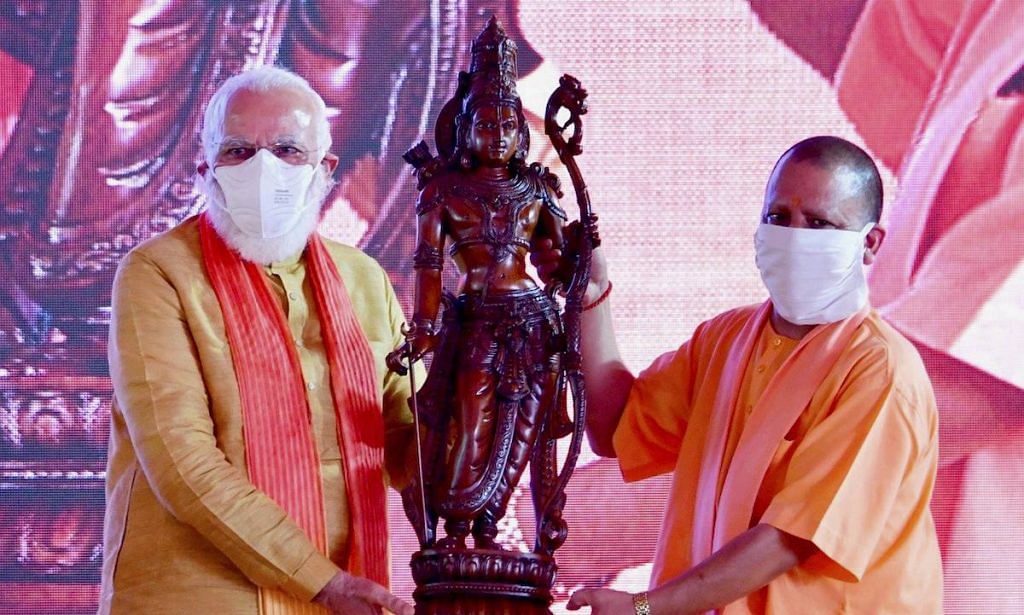The Bharatiya Janata Party fought the 2017 assembly election in Uttar Pradesh with a simple binary—Narendra Modi versus others—with everything else subsumed into it. For 2022, it has set the stage for yet another binary—Ram versus others.
With the grand bhoomi pujan ceremony in Ayodhya last week, Narendra Modi and Amit Shah’s BJP has set the tone for the 2022 UP assembly election, and possibly even the 2024 Lok Sabha polls — if you are with Ram, you are with us, else you are with the rest.
The use of a George Bush-esque binary—either you are with us, or you are with the terrorists—is clever, forcing the voter to see the situation as a zero-sum game and pushing opponents into a very uncomfortable and slippery corner.
The BJP is well aware of this political art, and deploying binaries has been its old trick—from the ‘are you with Babur ke aulad or are you with Ram’ in the early 1990s when the Ram Janmabhoomi movement was at its peak, to the constant ‘are you with Pakistan or us’, and now the overarching Narendra Modi versus the rest.
The Uttar Pradesh election is arguably the most crucial in India, setting the tone for the Lok Sabha election that follows two years later. After acing the state in 2017 as well as in the 2019 Lok Sabha election, the 2022 polls are a prestige issue for Modi and Shah, and a fresh ‘this versus that’ question will form the core of this critical campaign.
Also read: Art 370, CAA, triple talaq, Ram Mandir are just one cycle of Modi’s ‘permanent revolution’
The Ram factor
The Modi-Shah duo is well aware of the need to put the opposition in a box, from where it finds it difficult to extract itself unscathed and is forced to operate as per the narrative set by the BJP. Binaries conveniently achieve that purpose.
In 2017, Modi was an overwhelming brand in Uttar Pradesh, with the BJP needing little else. Amit Shah’s arithmetic and a carefully calibrated caste equation were both useful but only became enabling factors, with Modi remaining the core. When I travelled across the state extensively to cover the election, all I heard was voters chanting Modi’s name, wanting to vote for him, with many even unaware of their local BJP candidate’s name.
By making the election a Modi’s brand versus rest affair, the BJP forced the opposition to react on similar lines.
To counter the brand, the Samajwadi Party and Congress joined hands and created what they thought was a super-brand. But the ‘UP ke ladke’ — Akhilesh Yadav and Rahul Gandhi — failed because against BJP’s binary game, they stood little chance.
For 2022, the Modi factor cannot be key. The last assembly election didn’t have a CM face, but this time, Yogi Adityanath cannot be wished away. Hence, the party has decided to field Ram. If you believe in Ram, you have to be with the party that has fought for his ‘janmabhoomi’ and is constructing the ‘bhavya, gaganchumbhi’ Ram Mandir in the state. If you’re not with the BJP, then you are with those who question Ram and have done nothing for Him.
The opposition will be forced to play the BJP’s game. The Congress’ flirting with ‘soft-Hindutva’ has now become far more overt and brazen, with its top leaders falling over each other to welcome the temple and hail Ram, and quietly forgetting Babri Masjid. The other stakeholders — Akhilesh Yadav’s Samajwadi Party and Mayawati’s Bahujan Samaj Party are not far behind, going all out to woo the upper caste Hindu voters, promising a statue of Parshuram, the warrior believed to be the sixth avatar of Lord Vishnu.
That Ram was going to be BJP’s key card in the 2022 UP election is a foregone conclusion, but it is the ‘this or that’ narrative is what gives Modi-Shah the most potent tool.
Also read: Bhoomipujan 2020 is like Balakot 2019, the surgical strike that washes all sins
The game of binaries
When the Ram Janmabhoomi movement peaked in the early 1990s, the fight was between those who believed in Ram and those who owed their allegiance to ‘Babur’.
Decades later, the BJP’s top leadership may have changed, but the game hasn’t. For Modi and Shah, Pakistan is always the convenient other, and those who are not with it, are supporters of the Muslim nation. Ahead of the Bihar election in 2015, Amit Shah had said if the BJP loses in Bihar, ‘patakas’ will go off in Pakistan.
In the run up to the 2002 Gujarat assembly election, Modi deployed a familiar tactic when he made it about Hindu patriots against ‘Mian Musharraf’. Cut to the current era, and there are binaries galore. The us-versus-them game has many manifestations for the BJP—the other is the Bangladeshi ‘infiltrator’, or the ‘urban Naxals’, or the ‘tukde tukde gang’, or the ‘anti-nationals’ — whatever best fits the bill and the election in question.
The 2019 Lok Sabha poll was also built on one big binary that PM Modi created — the naamdaar versus kaamdaar (the entitled versus the worker) — with the latter defining himself through ‘hard work’ and the former, pretty much all political dynasties.
The party creates options that seem like easy choices for many voters. After all, who supports Pakistan? Or who likes the ‘tukde tukde gang’? Or who can support the entitled lot? And now, which good Hindu—or anyone in this climate—can go against Ram?
Well, temple by then or not, Ram had better brace himself to be the star of BJP’s 2022 Uttar Pradesh campaigner.
Views are personal.
